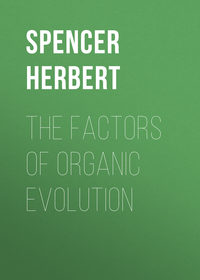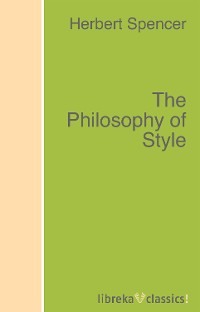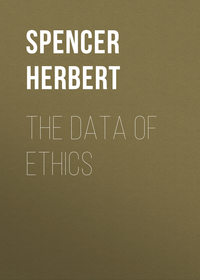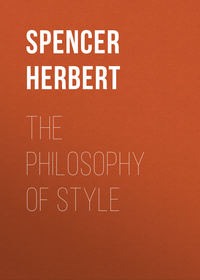 полная версия
полная версияEssays on Education and Kindred Subjects
Before going on to show how organic progress also depends upon the universal law that every force produces more than one change, we have to notice the manifestation of this law in yet another species of inorganic progress – namely, chemical. The same general causes that have wrought out the heterogeneity of the Earth, physically considered, have simultaneously wrought out its chemical heterogeneity. Without dwelling upon the general fact that the forces which have been increasing the variety and complexity of geological formations, have, at the same time, been bringing into contact elements not previously exposed to each other under conditions favourable to union, and so have been adding to the number of chemical compounds, let us pass to the more important complications that have resulted from the cooling of the Earth.
There is every reason to believe that at an extreme heat the elements cannot combine. Even under such heat as can be artificially produced, some very strong affinities yield, as for instance, that of oxygen for hydrogen; and the great majority of chemical compounds are decomposed at much lower temperatures. But without insisting upon the highly probable inference, that when the Earth was in its first state of incandescence there were no chemical combinations at all, it will suffice our purpose to point to the unquestionable fact that the compounds that can exist at the highest temperatures, and which must, therefore, have been the first that were formed as the Earth cooled, are those of the simplest constitutions. The protoxides – including under that head the alkalies, earths, etc. – are, as a class, the most stable compounds we know: most of them resisting decomposition by any heat we can generate. These, consisting severally of one atom of each component element, are combinations of the simplest order – are but one degree less homogeneous than the elements themselves. More heterogeneous than these, less stable, and therefore later in the Earth's history, are the deutoxides, tritoxides, peroxides, etc.; in which two, three, four, or more atoms of oxygen are united with one atom of metal or other element. Higher than these in heterogeneity are the hydrates; in which an oxide of hydrogen, united with an oxide of some other element, forms a substance whose atoms severally contain at least four ultimate atoms of three different kinds. Yet more heterogeneous and less stable still are the salts; which present us with compound atoms each made up of five, six, seven, eight, ten, twelve, or more atoms, of three, if not more, kinds. Then there are the hydrated salts, of a yet greater heterogeneity, which undergo partial decomposition at much lower temperatures. After them come the further-complicated supersalts and double salts, having a stability again decreased; and so throughout. Without entering into qualifications for which we lack space, we believe no chemist will deny it to be a general law of these inorganic combinations that, other things equal, the stability decreases as the complexity increases.
And then when we pass to the compounds of organic chemistry, we find this general law still further exemplified: we find much greater complexity and much less stability. An atom of albumen, for instance, consists of 482 ultimate atoms of five different kinds. Fibrine, still more intricate in constitution, contains in each atom, 298 atoms of carbon, 40 of nitrogen, 2 of sulphur, 228 of hydrogen, and 92 of oxygen – in all, 660 atoms; or, more strictly speaking – equivalents. And these two substances are so unstable as to decompose at quite ordinary temperatures; as that to which the outside of a joint of roast meat is exposed. Thus it is manifest that the present chemical heterogeneity of the Earth's surface has arisen by degrees, as the decrease of heat has permitted; and that it has shown itself in three forms – first, in the multiplication of chemical compounds; second, in the greater number of different elements contained in the more modern of these compounds: and third, in the higher and more varied multiples in which these more numerous elements combine.
To say that this advance in chemical heterogeneity is due to the one cause, diminution of the Earth's temperature, would be to say too much; for it is clear that aqueous and atmospheric agencies have been concerned; and, further, that the affinities of the elements themselves are implied. The cause has all along been a composite one: the cooling of the Earth having been simply the most general of the concurrent causes, or assemblage of conditions. And here, indeed, it may be remarked that in the several classes of facts already dealt with (excepting, perhaps, the first), and still more in those with which we shall presently deal, the causes are more or less compound; as indeed are nearly all causes with which we are acquainted. Scarcely any change can with logical accuracy be wholly ascribed to one agency, to the neglect of the permanent or temporary conditions under which only this agency produces the change. But as it does not materially affect our argument, we prefer, for simplicity's sake, to use throughout the popular mode of expression.
Perhaps it will be further objected, that to assign loss of heat as the cause of any changes, is to attribute these changes not to a force, but to the absence of a force. And this is true. Strictly speaking, the changes should be attributed to those forces which come into action when the antagonist force is withdrawn. But though there is an inaccuracy in saying that the freezing of water is due to the loss of its heat, no practical error arises from it; nor will a parallel laxity of expression vitiate our statements respecting the multiplication of effects. Indeed, the objection serves but to draw attention to the fact, that not only does the exertion of a force produce more than one change, but the withdrawal of a force produces more than one change. And this suggests that perhaps the most correct statement of our general principle would be its most abstract statement – every change is followed by more than one other change.
Returning to the thread of our exposition, we have next to trace out, in organic progress, this same all-pervading principle. And here, where the evolution of the homogeneous into the heterogeneous was first observed, the production of many changes by one cause is least easy to demonstrate. The development of a seed into a plant, or an ovum into an animal, is so gradual, while the forces which determine it are so involved, and at the same time so unobtrusive, that it is difficult to detect the multiplication of effects which is elsewhere so obvious. Nevertheless, guided by indirect evidence, we may pretty safely reach the conclusion that here too the law holds.
Observe, first, how numerous are the effects which any marked change works upon an adult organism – a human being, for instance. An alarming sound or sigh, besides the impressions on the organs of sense and the nerves, may produce a start, a scream, a distortion of the face, a trembling consequent upon a general muscular relaxation, a burst of perspiration, an excited action of the heart, a rush of blood to the brain, followed possibly by arrest of the heart's action and by syncope: and if the system be feeble, an indisposition with its long train of complicated symptoms may set in. Similarly in cases of disease. A minute portion of the small-pox virus introduced into the system, will, in a severe case, cause, during the first stage, rigors, heat of skin, accelerated pulse, furred tongue, loss of appetite, thirst, epigastric uneasiness, vomiting, headache, pains in the back and limbs, muscular weakness, convulsions, delirium, etc.; in the second stage, cutaneous eruption, itching, tingling, sore throat, swelled fauces, salivation, cough, hoarseness, dyspnœa, etc.; and in the third stage, œdematous inflammations, pneumonia, pleurisy, diarrhœa, inflammation of the brain, ophthalmia, erysipelas, etc.; each of which enumerated symptoms is itself more or less complex. Medicines, special foods, better air, might in like manner be instanced as producing multiplied results.
Now it needs only to consider that the many changes thus wrought by one force upon an adult organism, will be in part paralleled in an embryo organism, to understand how here also, the evolution of the homogeneous into the heterogeneous may be due to the production of many effects by one cause. The external heat and other agencies which determine the first complications of the germ, may, by acting upon these, superinduce further complications; upon these still higher and more numerous ones; and so on continually: each organ as it is developed serving, by its actions and reactions upon the rest, to initiate new complexities. The first pulsations of the fœtal heart must simultaneously aid the unfolding of every part. The growth of each tissue, by taking from the blood special proportions of elements, must modify the constitution of the blood; and so must modify the nutrition of all the other tissues. The heart's action, implying as it does a certain waste, necessitates an addition to the blood of effete matters, which must influence the rest of the system, and perhaps, as some think, cause the formation of excretory organs. The nervous connections established among the viscera must further multiply their mutual influences: and so continually.
Still stronger becomes the probability of this view when we call to mind the fact, that the same germ may be evolved into different forms according to circumstances. Thus, during its earlier stages, every embryo is sexless – becomes either male or female as the balance of forces acting upon it determines. Again, it is a well-established fact that the larva of a working-bee will develop into a queen-bee, if, before it is too late, its food be changed to that on which the larvæ of queen-bees are fed. Even more remarkable is the case of certain entozoa. The ovum of a tape-worm, getting into its natural habitat, the intestine, unfolds into the well-known form of its parent; but if carried, as it frequently is, into other parts of the system, it becomes a sac-like creature, called by naturalists the Echinococcus– a creature so extremely different from the tape-worm in aspect and structure, that only after careful investigations has it been proved to have the same origin. All which instances imply that each advance in embryonic complication results from the action of incident forces upon the complication previously existing.
Indeed, we may find à priori reason to think that the evolution proceeds after this manner. For since it is now known that no germ, animal or vegetable, contains the slightest rudiment, trace, or indication of the future organism – now that the microscope has shown us that the first process set up in every fertilised germ, is a process of repeated spontaneous fissions ending in the production of a mass of cells, not one of which exhibits any special character: there seems no alternative but to suppose that the partial organisation at any moment subsisting in a growing embryo, is transformed by the agencies acting upon it into the succeeding phase of organisation, and this into the next, until, through ever-increasing complexities, the ultimate form is reached. Thus, though the subtilty of the forces and the slowness of the results, prevent us from directly showing that the stages of increasing heterogeneity through which every embryo passes, severally arise from the production of many changes by one force, yet, indirectly, we have strong evidence that they do so.
We have marked how multitudinous are the effects which one cause may generate in an adult organism; that a like multiplication of effects must happen in the unfolding organism, we have observed in sundry illustrative cases; further, it has been pointed out that the ability which like germs have to originate unlike forms, implies that the successive transformations result from the new changes superinduced on previous changes; and we have seen that structureless as every germ originally is, the development of an organism out of it is otherwise incomprehensible. Not indeed that we can thus really explain the production of any plant or animal. We are still in the dark respecting those mysterious properties in virtue of which the germ, when subject to fit influences, undergoes the special changes that begin the series of transformations. All we aim to show, is, that given a germ possessing these mysterious properties, the evolution of an organism from it, probably depends upon that multiplication of effects which we have seen to be the cause of progress in general, so far as we have yet traced it.
When, leaving the development of single plants and animals, we pass to that of the Earth's flora and fauna, the course of our argument again becomes clear and simple. Though, as was admitted in the first part of this article, the fragmentary facts Palæontology has accumulated, do not clearly warrant us in saying that, in the lapse of geologic time, there have been evolved more heterogeneous organisms, and more heterogeneous assemblages of organisms, yet we shall now see that there must ever have been a tendency towards these results. We shall find that the production of many effects by one cause, which, as already shown, has been all along increasing the physical heterogeneity of the Earth, has further involved an increasing heterogeneity in its flora and fauna, individually and collectively. An illustration will make this clear.
Suppose that by a series of upheavals, occurring, as they are now known to do, at long intervals, the East Indian Archipelago were to be, step by step, raised into a continent, and a chain of mountains formed along the axis of elevation. By the first of these upheavals, the plants and animals inhabiting Borneo, Sumatra, New Guinea, and the rest, would be subjected to slightly modified sets of conditions. The climate in general would be altered in temperature, in humidity, and in its periodical variations; while the local differences would be multiplied. These modifications would affect, perhaps inappreciably, the entire flora and fauna of the region. The change of level would produce additional modifications: varying in different species, and also in different members of the same species, according to their distance from the axis of elevation. Plants, growing only on the sea-shore in special localities, might become extinct. Others, living only in swamps of a certain humidity, would, if they survived at all, probably undergo visible changes of appearance. While still greater alterations would occur in the plants gradually spreading over the lands newly raised above the sea. The animals and insects living on these modified plants, would themselves be in some degree modified by change of food, as well as by change of climate; and the modification would be more marked where, from the dwindling or disappearance of one kind of plant, an allied kind was eaten. In the lapse of the many generations arising before the next upheaval, the sensible or insensible alterations thus produced in each species would become organised – there would be a more or less complete adaptation to the new conditions. The next upheaval would superinduce further organic changes, implying wider divergences from the primary forms; and so repeatedly.
But now let it be observed that the revolution thus resulting would not be a substitution of a thousand more or less modified species for the thousand original species; but in place of the thousand original species there would arise several thousand species, or varieties, or changed forms. Each species being distributed over an area of some extent, and tending continually to colonise the new area exposed, its different members would be subject to different sets of changes. Plants and animals spreading towards the equator would not be affected in the same way with others spreading from it. Those spreading towards the new shores would undergo changes unlike the changes undergone by those spreading into the mountains. Thus, each original race of organisms, would become the root from which diverged several races differing more or less from it and from each other; and while some of these might subsequently disappear, probably more than one would survive in the next geologic period: the very dispersion itself increasing the chances of survival. Not only would there be certain modifications thus caused by change of physical conditions and food, but also in some cases other modifications caused by change of habit. The fauna of each island, peopling, step by step, the newly-raised tracts, would eventually come in contact with the faunas of other islands; and some members of these other faunas would be unlike any creatures before seen. Herbivores meeting with new beasts of prey, would, in some cases, be led into modes of defence or escape differing from those previously used; and simultaneously the beasts of prey would modify their modes of pursuit and attack. We know that when circumstances demand it, such changes of habit do take place in animals; and we know that if the new habits become the dominant ones, they must eventually in some degree alter the organisation.
Observe, now, however, a further consequence. There must arise not simply a tendency towards the differentiation of each race of organisms into several races; but also a tendency to the occasional production of a somewhat higher organism. Taken in the mass, these divergent varieties which have been caused by fresh physical conditions and habits of life, will exhibit changes quite indefinite in kind and degree; and changes that do not necessarily constitute an advance. Probably in most cases the modified type will be neither more nor less heterogeneous than the original one. In some cases the habits of life adopted being simpler than before, a less heterogeneous structure will result: there will be a retrogradation. But it must now and then occur, that some division of a species, falling into circumstances which give it rather more complex experiences, and demand actions somewhat more involved, will have certain of its organs further differentiated in proportionately small degrees, – will become slightly more heterogeneous.
Thus, in the natural course of things, there will from time to time arise an increased heterogeneity both of the Earth's flora and fauna, and of individual races included in them. Omitting detailed explanations, and allowing for the qualifications which cannot here be specified, we think it is clear that geological mutations have all along tended to complicate the forms of life, whether regarded separately or collectively. The same causes which have led to the evolution of the Earth's crust from the simple into the complex, have simultaneously led to a parallel evolution of the Life upon its surface. In this case, as in previous ones, we see that the transformation of the homogeneous into the heterogeneous is consequent upon the universal principle, that every active force produces more than one change.
The deduction here drawn from the established truths of geology and the general laws of life, gains immensely in weight on finding it to be in harmony with an induction drawn from direct experience. Just that divergence of many races from one race, which we inferred must have been continually occurring during geologic time, we know to have occurred during the pre-historic and historic periods, in man and domestic animals. And just that multiplication of effects which we concluded must have produced the first, we see has produced the last. Single causes, as famine, pressure of population, war, have periodically led to further dispersions of mankind and of dependent creatures: each such dispersion initiating new modifications, new varieties of type. Whether all the human races be or be not derived from one stock, philology makes it clear that whole groups of races now easily distinguishable from each other, were originally one race, – that the diffusion of one race into different climates and conditions of existence, has produced many modified forms of it.
Similarly with domestic animals. Though in some cases – as that of dogs – community of origin will perhaps be disputed, yet in other cases – as that of the sheep or the cattle of our own country – it will not be questioned that local differences of climate, food, and treatment, have transformed one original breed into numerous breeds now become so far distinct as to produce unstable hybrids. Moreover, through the complications of effects flowing from single causes, we here find, what we before inferred, not only an increase of general heterogeneity, but also of special heterogeneity. While of the divergent divisions and subdivisions of the human race, many have undergone changes not constituting an advance; while in some the type may have degraded; in others it has become decidedly more heterogeneous. The civilised European departs more widely from the vertebrate archetype than does the savage. Thus, both the law and the cause of progress, which, from lack of evidence, can be but hypothetically substantiated in respect of the earlier forms of life on our globe, can be actually substantiated in respect of the latest forms.
If the advance of Man towards greater heterogeneity is traceable to the production of many effects by one cause, still more clearly may the advance of Society towards greater heterogeneity be so explained. Consider the growth of an industrial organisation. When, as must occasionally happen, some individual of a tribe displays unusual aptitude for making an article of general use – a weapon, for instance – which was before made by each man for himself, there arises a tendency towards the differentiation of that individual into a maker of such weapon. His companions – warriors and hunters all of them, – severally feel the importance of having the best weapons that can be made; and are therefore certain to offer strong inducements to this skilled individual to make weapons for them. He, on the other hand, having not only an unusual faculty, but an unusual liking, for making such weapons (the talent and the desire for any occupation being commonly associated), is predisposed to fulfil these commissions on the offer of an adequate reward: especially as his love of distinction is also gratified. This first specialisation of function, once commenced, tends ever to become more decided. On the side of the weapon-maker continued practice gives increased skill – increased superiority to his products: on the side of his clients, cessation of practice entails decreased skill. Thus the influences that determine this division of labour grow stronger in both ways; and the incipient heterogeneity is, on the average of cases, likely to become permanent for that generation, if no longer.
Observe now, however, that this process not only differentiates the social mass into two parts, the one monopolising, or almost monopolising, the performance of a certain function, and the other having lost the habit, and in some measure the power, of performing that function; but it tends to imitate other differentiations. The advance we have described implies the introduction of barter, – the maker of weapons has, on each occasion, to be paid in such other articles as he agrees to take in exchange. But he will not habitually take in exchange one kind of article, but many kinds. He does not want mats only, or skins, or fishing gear, but he wants all these; and on each occasion will bargain for the particular things he most needs. What follows? If among the members of the tribe there exist any slight differences of skill in the manufacture of these various things, as there are almost sure to do, the weapon-maker will take from each one the thing which that one excels in making: he will exchange for mats with him whose mats are superior, and will bargain for the fishing gear of whoever has the best. But he who has bartered away his mats or his fishing gear, must make other mats or fishing gear for himself; and in so doing must, in some degree, further develop his aptitude. Thus it results that the small specialities of faculty possessed by various members of the tribe, will tend to grow more decided. If such transactions are from time to time repeated, these specialisations may become appreciable. And whether or not there ensue distinct differentiations of other individuals into makers of particular articles, it is clear that incipient differentiations take place throughout the tribe: the one original cause produces not only the first dual effect, but a number of secondary dual effects, like in kind, but minor in degree. This process, of which traces may be seen among groups of schoolboys, cannot well produce any lasting effects in an unsettled tribe; but where there grows up a fixed and multiplying community, these differentiations become permanent, and increase with each generation. A larger population, involving a greater demand for every commodity, intensifies the functional activity of each specialised person or class; and this renders the specialisation more definite where it already exists, and establishes it where it is nascent. By increasing the pressure on the means of subsistence, a larger population again augments these results; seeing that each person is forced more and more to confine himself to that which he can do best, and by which he can gain most. This industrial progress, by aiding future production, opens the way for a further growth of population, which reacts as before: in all which the multiplication of effects is manifest. Presently, under these same stimuli, new occupations arise. Competing workers, ever aiming to produce improved articles, occasionally discover better processes or raw materials. In weapons and cutting tools, the substitution of bronze for stone entails upon him who first makes it a great increase of demand – so great an increase that he presently finds all his time occupied in making the bronze for the articles he sells, and is obliged to depute the fashioning of these to others: and, eventually, the making of bronze, thus gradually differentiated from a pre-existing occupation, becomes an occupation by itself.









